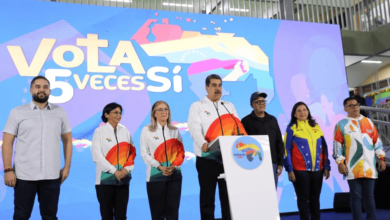Storm clouds are brewing over Latin America. Those clouds are U.S. aggression aimed at popular movements throughout the region—from Bolivia to Venezuela to Argentina.
In what is certainly a U.S.-engineered intelligence operation, the U.S. government is attempting to smear the election
|
In August, Guido Antonini Wilson, a Venezuelan-U.S. dual citizen was arrested trying to enter Argentina on a chartered flight with $800,000 in cash. The intention of anyone carrying a suitcase with such a massive amount of money across international borders presumably is to get caught. It is a blatant plot cooked up in Washington.
Now the U.S. has arrested four men, including Antonini Wilson, and charged them with being unregistered foreign agents from Venezuela. Argentina’s president has strongly rejected the charges: “This president might be a woman, but she won’t let herself be pressured. … I’m going to continue to strengthen relations with all friendly Latin American nations, including the Bolivarian Republic of Venezuela.”
For the United States to accuse anyone of interference in another’s elections is hypocrisy beyond belief. The Empire wrote the book on how to buy and engineer elections.
The U.S. maneuvers clearly are intended to isolate Venezuela’s and Cuba’s revolutionary governments and to divide the alliance they are creating in Latin America.
As Fernández said on Dec. 13: “More than friends, they [the U.S. government] want subservient and subordinated countries.”
Chávez recently was the primary mediator in an exchange of prisoners between Colombia and the Revolutionary Armed Forces of Colombia, the FARC. Days before the Dec. 2 Venezuelan referendum, Colombia’s right-wing president Álvaro Uribe declared he would no longer work with Chávez, undoubtedly on instructions from Washington.
Destabilization attempts are also targeting the Bolivian people’s struggle for justice.
On Dec. 9, a new Bolivian Constituent Assembly approved a draft constitution by the required two-thirds vote. It passed despite obstacles, including violence, by the right-wing, which tried desperately to derail the process.
As the assembly deputies met in Sucre in late November, fascist thugs attacked the participants and set public buildings on fire. Several people were killed, and the meeting had to be moved to Oruro in the highlands on Dec. 8. Two days later, it was approved.
The draft’s passage is a step forward for the most oppressed of Bolivian society, the people of the 36 Indigenous ethnicities, all peasants and the workers. It would grant greater rights and autonomy to the Indigenous and lay the basis to keep state control of natural resources.
The only article out of 411 not agreed to by the assembly concerns the size limit of landholdings, a sign of the growing class conflict between landless peasants and extremely wealthy landowners, who are behind the secessionist movement.
Before a popular referendum is held on the constitution draft, first the article on the size of landholdings will be placed before the public to approve or reject. If accepted, it would be added to the constitution for a final referendum vote.
Bolivia’s tiny minority of racist oligarchs has lorded over the mostly Indigenous population for decades. But now, it is fully aware that the majority of people back Morales and will likely approve the constitution. No date has been set for the referendum vote. Morales took office in January 2006.
Counting the numbers and seeing the writing on the wall, the oligarchy’s main party PODEMOS and its allies are now acting on their threat to break away.
Secession and coup rumors are the greatest danger to Evo Morales’ presidency, his Movement Toward Socialism (MAS) and the Bolivian masses.
The prefects (governing officials) in four of Bolivia’s five opposition-led departments (similar to states) announced on Dec. 15 that they would gather signatures for referendums on autonomy. The prefects of Cochabamba and Chuquisaca may do the same.
The four departments led by the “autonomists” are Santa Cruz, Beni, Tarija and Pando. With 60 percent of Bolivia’s territory and 35 percent of the country’s population in the lowland plains, it is the richest region with natural resources, fertile land and industrial development. Due to its geographical shape, the area is known as the “Media luna (half moon).”
The western part of Bolivia is highlands, encompassing four departments, where the Indigenous and poorest of the population live. It is the area where leftist president Evo Morales has the most support.
Morales has called for a recall referendum on all the prefects and himself. He is calculating that the majority of the masses in the breakaway departments will oust the right-wing prefects.
Behind the opposition is the hand of the U.S. government. Bolivian Vice President Alvaro García accused Washington of funding right-wing groups to destabilize the government, partly through USAID, notorious for backing counterrevolutionary movements.
The historic violence of the oligarchy and its entrenched rule has made Morales’s attempts at major economic and social change difficult to achieve. The move to nationalize Bolivia’s large oil and gas reserves has been stymied.
The fate of Bolivia is tied with the rest of Latin America. The U.S. imperialists know this and are working overtime to reverse popular gains won by struggle.
But the decisive outcome is in the hands of the Latin American masses, led by socialist Cuba and revolutionary Venezuela.







